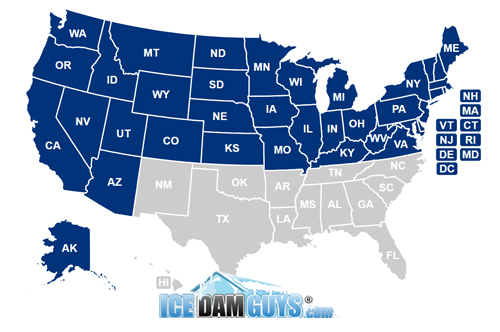What Causes Ice Dams? Only 4 Ways an Ice Dam Can Form
To prevent an ice dam, you need to know how they form in the first place. Ice dams can form for any of 4 reasons:
Ice Dam Cause #1: Hot Attic
This is the most common way ice dams form. It happens when your home is simply not energy-efficient.
- You don’t have enough insulation in your attic.
- You don’t have enough ventilation in your attic.
- “Attic bypasses”: poorly insulated areas like outlets, light fixtures, and attic doors, that allow warm air to sneak up into your attic. Virtually any penetration through your walls or ceilings is a potential bypass that sends heat into your attic. In some homes, non-insulated heat ducts may run through the attic, making it difficult to keep your attic cool. On top of that, certain ventilation systems (commonly found in bathrooms and kitchens) are terminated in the attic vs. being exhausted through the roof, outside.
Most ice dams form as a result of a hot attic. A hot attic means a hot roof, and a hot roof means ideal conditions for ice dams to form. You can minimize your chances of getting ice dams simply by having a home energy audit done and following all of the recommendations that you’re given. Just make sure your auditor is ice-dam-savvy.
Ice Dam Cause #2: Fluctuating Temperatures
Some causes of ice dams are out of your hands.
You’re looking at perfect ice dam conditions when you see temperatures slightly above freezing during the day, but well below freezing during the night. At this point it doesn’t matter how warm or cool your roof is, because the snow melts during the day and refreezes at night. It’s only a matter of time before ice builds up along your overhangs or in your valleys, or on other parts of your roof.
If you see these conditions, your best bet is to rake as much snow off of your roof as possible. If there’s no snow to melt, there’s no melting snow to refreeze.
Ice Dam Cause #3: Radiant Heat from the Sun
Temperatures can hold below freezing during the day and during the night, but ice dams can continue to form if the radiant heat from the sun manages to melt the snow on your roof, despite the ambient temperature being below freezing.
That’s just bad luck, and there’s not much you can do. Radiant heat is almost impossible to predict. The weather person won’t talk about it, and there’s no easy way for you to measure it. That is why we will never tell you there are any fool-proof ways to prevent ice dams completely.
Once again, the best bet here is to remove the snow from your roof. Either rake as much as you can from the ground, or call a professional to have it all removed.
Ice Dam Cause #4: Perfect Temperatures
Be wary of ice dams when temperatures sit between 30 and 32 degrees – right at freezing, or just under freezing.
Why? Because at that point even an energy-efficient home can start sprouting ice dams. It just doesn’t take much heat from your home to push the roof temperature above freezing. Consider this: you’ll only have to raise your roof temperature by 1 degree on a 32-degree day to get water flowing, until it hits the cold overhangs and refreezes.
In these conditions, aside from the obvious (removing the snow from your roof), you might think about turning down your thermostat a little. It’s a small precaution you can take, and it just might save you a visit from an Ice Dam Guys® pro (and a few bucks in energy savings).
Yes, energy audits, roof-raking, and lowering the temperature in your home are hassles. But they will significantly reduce your chances of getting an ice dam.
Even if you do get an ice dam, that ice dam you worked hard to prevent will probably be smaller and less damaging than an ice dam for which you left out a welcome mat.
Though ice dams can form despite your best efforts, your best efforts are still more than worth it.






















